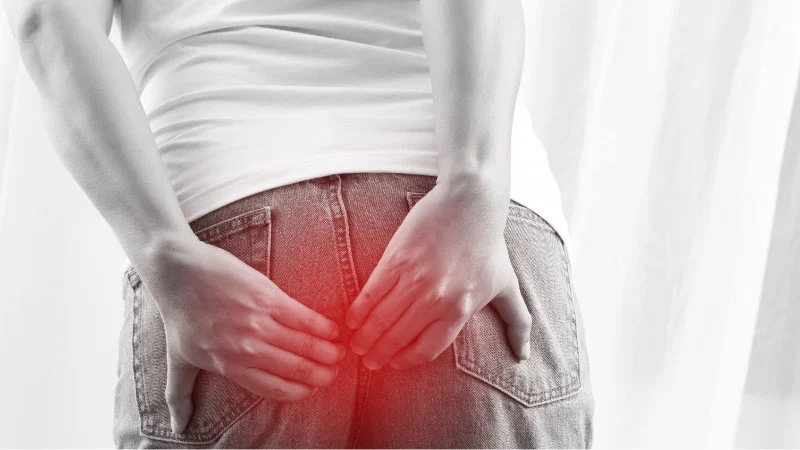Hemorrhoids are a condition resulting from the swelling of veins in the lower part of the anus or rectum. This swelling often leads to symptoms such as pain, itching, and sometimes bleeding during bowel movements. Hemorrhoids are classified into two main types:

Internal Hemorrhoids: These form inside the rectum and are usually painless because there are very few pain receptors in this area. However, they can manifest through bleeding during bowel movements.
External Hemorrhoids: These occur outside, around the anus. They can be painful due to the area being surrounded by pain-sensitive nerves. Swelling, itching, or discomfort during bowel movements can occur.
Stages:
- Stage 1: At this stage, hemorrhoids are internal and do not protrude outside. They are usually painless, and the most common symptom is bleeding during bowel movements, which is typically bright red and can drip onto toilet paper or into the toilet.
- Stage 2: They may protrude outside during bowel movements but retract on their own. Bleeding and mild discomfort may be present at this stage.
- Stage 3: They protrude during bowel movements and need to be manually pushed back inside. Pain, itching, and discomfort can become more pronounced.
- Stage 4: They remain outside permanently and cannot be pushed back in. This is the most severe stage, causing significant pain, itching, and discomfort. The risk of infection also increases in this stage.
Causes of Hemorrhoids:
- Constipation or Diarrhea: Prolonged constipation or diarrhea can strain the veins in the anus area, posing a risk.
- Sitting on the Toilet for Long Periods: Sitting on the toilet for extended periods puts pressure on the veins in the anus area.
- Obesity: Excess weight puts extra pressure on the veins in the pelvic area.
- Pregnancy: The growth of the uterus during pregnancy puts pressure on the veins in the pelvic area, and hormonal changes can cause the veins to expand, especially increasing the risk during childbirth.
- Aging: The body’s support tissues may weaken as one ages.
- Heavy Lifting: Regularly lifting heavy objects puts pressure on the veins in the pelvic and rectal areas.
- Genetic Predisposition: Individuals with a family history of hemorrhoids may be at a higher risk.
- Insufficient Fiber Intake: Insufficient dietary fiber can lead to constipation and, consequently, hemorrhoids.
- Prolonged Sitting or Standing: Prolonged sitting or standing can increase pressure on the veins in the pelvic area, raising the risk.
Symptoms of Hemorrhoids:
Symptoms can vary depending on the type (internal or external) and severity of the condition. The most common symptoms include:
General Symptoms:
- Bleeding: Bright red blood on toilet paper or in the toilet during bowel movements. Internal hemorrhoids typically cause painless bleeding, while bleeding is less common with external hemorrhoids.
- Pain and Discomfort: Especially with external hemorrhoids, there can be pain, burning, or itching around the anus.
- Swelling: Feeling one or more lumps around the anus, especially with external hemorrhoids.
Symptoms of Internal Hemorrhoids:
Internal hemorrhoids are usually painless because there are very few pain receptors inside the rectum. The most noticeable symptom is painless bleeding during bowel movements.
In advanced cases, the hemorrhoid may protrude during bowel movements and come out of the anus (prolapse). In such cases, the lump needs to be pushed back inside.
Symptoms of External Hemorrhoids:
Pain, itching, and burning around the anus. Discomfort during or after bowel movements. Hard lumps that can be felt externally.
Other Symptoms:
Moisture or discharge in the anus area. Increased discomfort after long periods of sitting or physical activity.
How Are Hemorrhoids Treated?
Treatment varies depending on the type (internal or external) and severity of symptoms. The goal of treatment is to alleviate symptoms, reduce discomfort, and prevent recurrence. Treatment options may include:
Home Care and Lifestyle Changes:
- High-Fiber Diet: Consuming foods rich in fiber (vegetables, fruits, whole grains) helps prevent constipation and keeps the stool soft.
- Water Intake: Drinking plenty of water softens the stool and reduces constipation.
- Warm Sitz Baths: Sitting in a warm water-filled tub for 10-15 minutes several times a day can relieve pain and swelling in the anal area.
- Toilet Habits: It’s important not to delay bowel movements and avoid sitting on the toilet for long periods.
Medication:
- Topical Treatments: Hemorrhoid creams, ointments, and suppositories can help alleviate pain and itching.
- Pain Relievers: Oral pain relievers can provide temporary relief.
Minimally Invasive Procedures:
These treatments are generally suitable for patients with severe symptoms but who do not require surgery.
- Band Ligation: A rubber band is placed around the base of the internal hemorrhoid to cause it to shrink and fall off within one or two weeks.
- Sclerotherapy: A chemical solution is injected to shrink the hemorrhoid.
- Infrared Coagulation: Infrared light is used to cut off blood flow to the hemorrhoid, causing the tissue to shrink.
Surgical Treatment:
Surgical treatment is usually reserved for more severe cases and includes:
- Hemorrhoidectomy: Surgical removal of external or prolapsed hemorrhoids.
- Hemorrhoidopexy: A less painful alternative procedure used to pull prolapsed internal hemorrhoids back inside the rectum and secure them.

